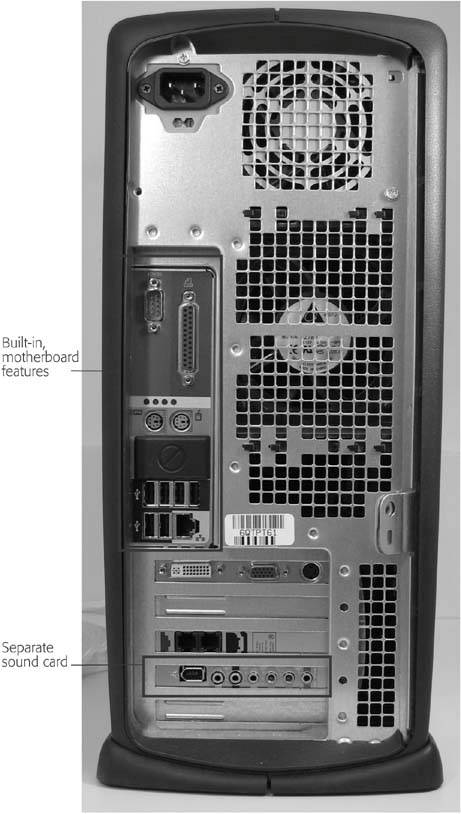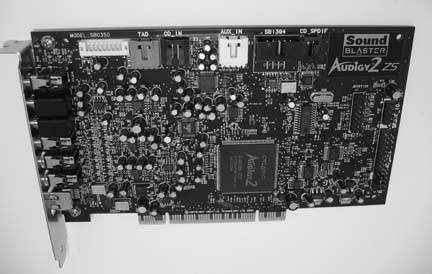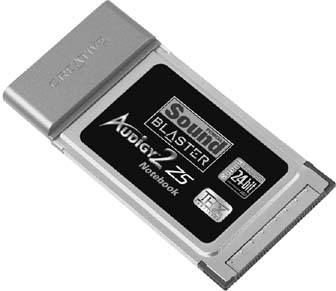Section 7.1. Understanding Sound Adapters (Sound Cards)
7.1. Understanding Sound Adapters (Sound Cards)The circuitry dishing up sound and music within your PC is technically called a sound adapter , but most people and computer stores simply call it a sound card . That term comes straight from your PC's history. Early PCs merely blurted out a single beep on startup, meant to reassure nervous owners that everything was working correctly. (More than two beeps, on the other hand, meant it was time to reach for the screwdriver.) The only way to improve a PC's sound back then was to spend $300 or more on a drop-in sound card (Section 7.1.1); most gamers gladly paid the premium. Today, all new PCs include stereo sound, but the circuitry lives in any of three different placeson the motherboard (Section 1.4), on a separate sound card, or inside a box that plugs into a USB port. To see which type of sound adapter lives inside your own PC, take a look at where your speaker cable plugs in to the PC; that cable's location shows you what type of sound circuitry your PC has.
Figure 7-1. All the ports contained in the rectangular area near the USB, mouse, and keyboard ports are built into the motherboard. If your speakers and microphone plug in up here, your sound circuitry is built into the motherboard, too. The ports on the parallel strips near the bottom of your PC are attached to add-on cards. If your speakers and microphone plug in down here, your PC has a sound card. Don't have any speakers at all? Then you're limited to headphones until you either plug your PC into your stereo (Section 7.3) or buy and plug in a cheap set of speakers. If you've got a laptop, check out the "Sound Advice for Laptops" box.) Each of the three types of adapter serves slightly different needs, all of which are described in the following sections. 7.1.1. Integrated AudioAll notebooks and most modern PCs rely on integrated audio . Listed on spec sheets and sales floors, the term simply means your PC's sound circuitry lives tucked away inside one of the motherboard's chips. Reducing the sound card's circuitry to a single chip lowers the PC's price, yet still lets your PC play stereo sound and record from a microphone or other gadget. A few years ago, the term "integrated audio" cried out "budget PC," leading to derisive scowls at geek gatherings. Integrated sound's come a long way since then, and some of today's new motherboards even include 5.1 surround sound for the most realistic rumbling helicopter explosions. In a few years, integrated audio will handle all of a PC's sounds, replacing everything but specialized cards aimed at musicians . 7.1.2. Sound CardsGamers and music fans tend to drool over high-performance sound cards, which drop into a special slot (Section 1.7.1) on your motherboard. A basic stereo card runs less than $20; a more elaborate one with higher-quality sound costs between $150 and $200. People upgrade to a sound card, shown in Figure 7-2, for several reasons.
Figure 7-2. Considered a high-end card, Creative Lab's Audigy 2 ZS slips inside your PC, granting it 7.1 sound. It powers a wall of three speakers in front, two in back, and one on each side. (Toss in the bass-producing subwoofer for the ".1" part.) Note: If you add a sound card to a PC, you may need to disable your PC's integrated audio by flipping a switch in its BIOS (see Section 17.2 for details). 7.1.3. Plug-in BoxSome sound circuitry doesn't live inside the PC at all. Instead, it resides in a separate box, as shown in Figure 7-3, that plugs into your computer's USB port. These boxes cost about the same as a sound card and come in handy for people who want better sound but shudder at the thought of opening up their PC's case. For instance, if your current sound card won't play your DVDs in surround sound, plug a box into a USB port, plug the speakers into the box, and listen to the helicopters whirl overhead. When shopping for a plug-in box, make sure it plugs into a FireWire or USB 2.0 port rather than the older USB 1.1 ports. The USB 2.0 ports move information 10 times faster than the older versions, which is vital when moving lots of sound information between the box and your PC. |
